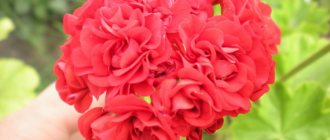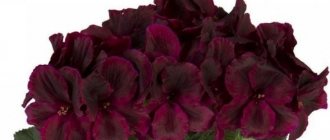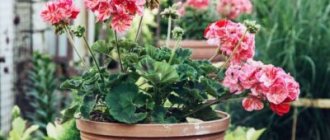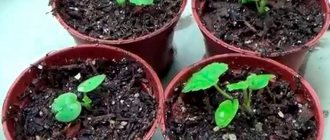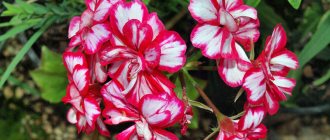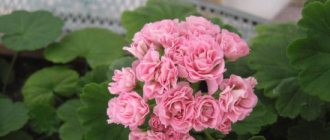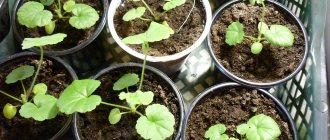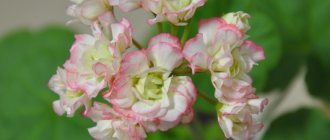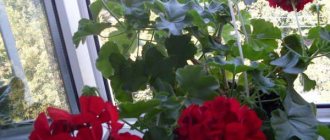A natural fragrance that grows on the windowsill and is always near you (and not somewhere in the store) is a dream that, thanks to fragrant pelargoniums, is coming true! The leaves of such pelargoniums are incredibly fragrant: just touch it and the aroma fills the room! When touched or rubbed, the leaves release an aroma similar to rose, apple, cinnamon, mint, lemon, orange, pineapple, peach, lavender, verbena, wormwood, pine, lily of the valley, ginger, juniper, cedar, almond, coconut, nutmeg, caramel, and sometimes have complex aromas (the aroma of balm, cologne, mossy forest, and even Coca-Cola drink!). Fragrant pelargonium (Pelargonium fragrans) has the smell of nutmeg, and most fragrant pelargonium (Pelargonium odoratissimum) has the smell of apple. If you collect dried flowers in glass vessels, you can create a whole collection of scents. Graveolens.
The flowers of fragrant pelargoniums are inferior in beauty to species and hybrid pelargoniums; they are usually small and dim, but some bloom elegantly due to the abundance of small flowers. Some pelargoniums hardly bloom on windowsills and are grown exclusively for their fragrant foliage. Moreover, their foliage can be unusual in shape, “curly”, and interesting.
The homeland of most fragrant pelargoniums is South Africa.
The essential oil of these plants varies greatly in composition and smell, even within the same species.
that smell like roses, mint and citruses are suitable for flavoring teas, drinks, and dishes
. Dried leaves are used and mixed with tea. Citrus-scented leaves can be used to season fish dishes and flavor vinegars and oils for salad dressings.
Geranium essential oil is widely used in perfumery and in the food industry, as well as in medicine (antiseptic and bactericidal properties). It is used to produce rose-scented perfumes, added to cosmetics, and used as a spice.
Fragrant pelargonium
The original fragrant species are included in the group Species, or wild pelargoniums (Pelargonium Species), and the group of pelargoniums with fragrant leaves (Scented Leaved Pelargoniums) combines the garden forms, varieties and hybrids obtained from them.
Most often these are bushy plants with small simple flowers, although there are varieties with large bright flowers and lush inflorescences. The leaves vary in size and shape among different varieties and can be variegated (variegated).
The main ancestors of this group are fragrant pelargonium (Pelargonium graveolens), fragrant pelargonium (Pelargnium odoratissimum), curly pelargonium (Pelargonium crispum), pink pelargonium (Pelargonium radens), oak-leaved pelargonium (Pelargonium quercifolium), capitate pelargonium (Pelargonium capitatum), argonium felt ( Pelargonium tomentosum), fragrant pelargonium (Pelargonium fragrans, recently it is assumed that it is a hybrid of P. exstipulatum and P. odoratissimum).
Other types of fragrant pelargoniums:
• birch leaf pelargonium (Pelargonium betulinum) – with a pungent aroma; • grape-leaved pelargonium (Pelargonium vitifolium) – with the scent of lemon balm; • guitar-shaped pelargonium (Pelargonium panduriforme) - with the aroma of geranium; • dichondrafolium pelargonium (Pelargonium dichondraefolium) – with the smell of black pepper; • sticky pelargonium (Pelargonium glutinosum) – with the scent of lemon balm; • pelargonium (Pelargonium cucullatum) – with a lemon aroma; • gooseberry-leaved pelargonium (Pelargonium grossularioides) - with a lemon aroma; • lemon balm pelargonium (Pelargonium mellisimum) – with a sweet lemon aroma; • small-flowered pelargonium (Pelargonium parviflorum) – with the scent of coconut; • hairy pelargonium (Pelargonium hirtum) – with a pungent aroma; • sickle-leaved pelargonium (Pelargonium crithmifolium) – with the aroma of ginger and nutmeg; • rough pelargonium (Pelargonium scabrum) – with the scent of lemon; • rough pelargonium (Pelargonium x asperum) • Pelargonium abrotanifolium – with a pungent aroma; • Pelargonium hypoleucum.
The most fragrant or most fragrant pelargonium. The most fragrant or fragrant pelargonium (Pelargonium odoratissimum) has a spreading shape, the bushes are low and seem to spread out in different directions. The leaves are round and almost not dissected. Plants can be used in flowerpots as hanging flowers. Depending on its origin, an essential oil can vary greatly in chemical composition and, accordingly, in therapeutic effect. There are samples with an apple scent.Torrento (Cola).
Fragrant pelargonium (Pelargonium graveolens), sometimes referred to as rose geranium. An old but very impressive variety, bred back in 1805, is Lady Plymouth with very elegant gray-green, heavily dissected leaves and bright pink flowers. The bushes branch beautifully and are well formed. The leaves have a pink aroma with a pronounced minty note.
The hybrid species Pelargonium x asperum Ehrhart ex Wildenow type Bourbon produces essential oil that is very valuable from the point of view of aromatherapists. It showed the greatest antiviral effect among geraniums .
Pelargonium capitatum is sometimes also referred to as rose geranium; the species has heart-shaped, highly dissected leaves, heavily pubescent, cyclamen-pink flowers and a pink aroma. There is a very old variety, Attar of Roses, known since 1800. It usually does not exceed 60 cm in height and is well suited for pots and containers.Pelargoniun radens/
Another species that claims to be pink pelargonium is Pelargoniun radens. It is characterized by leaves that are very strongly dissected into narrow segments. A dense, strong, highly branched shrub with pink flowers, reaching a height of 1.5 m, it needs to be constantly pruned to give it a shape acceptable for the room. Its leaves can smell of either rose or lemon.
Curly pelargonium (Pelargonium crispum) has a citrus aroma, small rounded leaves, more or less dissected. The Queen of Lemons variety, in addition to its lemon aroma, has elegant pink flowers. Lemon Fancy has small leaves with a rich lemon aroma; dark burgundy streaks are clearly visible on the light pink petals. The Prince of Orange variety has been known since 1820 and has a rich orange peel aroma. The flowers are large, light pink, like the previous variety, with dark burgundy streaks at the base.
What is the difference between caring for one and another plant at home?
To grow plants from this family, you do not need to purchase any expensive equipment. These plants need fertile soil with neutral or acidic soil. Geraniums need lighting, but without direct sunlight.
- Geranium is an outdoor plant , so it tolerates temperature changes more easily, while pelargonium is an indoor plant, and therefore requires more careful care.
Geranium can be propagated by seeds or vegetatively. The dry root purchased in the store must be slightly moistened and kept for several days at above-zero temperatures. After this, you can plant it in open ground. They do this in the spring. A bush already growing on the site is also divided in the spring. The bushes of the plant do not need to be protected from frost and the foliage should not be cut off from them. In the spring, you need to weed the ground around them well to protect the plant from pests. Read more about the main diseases of geranium and its pests, as well as disease prevention here. - Pelargonium is a heat-loving plant. It requires an air temperature of at least 12. It needs space on the windowsills so that other flowers do not interfere with its development.
Water the plant only after the top layer of soil has dried; if you overwater, the roots will begin to rot and the sprouts will weaken.The soil should be sand and peat. Drainage is used to remove excess moisture and loosen the soil. Flowers need to be constantly trimmed with leaves and dried petals removed.
Geranium and pelargonium are different varieties of plants that are quite popular among gardeners. But in order to grow a garden or indoor specimen, you need to take into account the features.
Varieties of fragrant pelargoniums
Felt pelargonium P. tomentosum Chocolate Mint (syn. Chocolate Peppermint) is low-growing, up to 30 cm tall, with slightly hanging shoots. The leaves are medium to large, deeply lobed, soft, velvety, with a chocolate brown spot in the center, and smell of mint. The flowers are pale pink, with purple feathers on the upper petals.P. crispum Cy's Sunburst.
Pelargonium capitatum P. capitatum Attar of Roses – up to 45 cm tall, with large trilobed leaves that have a strong rose aroma. The flowers are lilac-pink, with a burgundy throat.
Pelargonium curly P. crispum Cy's Sunburst - has small lemon-scented corrugated variegated foliage - green with a thin golden border. The flowers are pink.
Pelargonium P. quercifolium Giant Oak - with very large, lobed leaves with a balsamic scent.
Pelargonium pink P. radens Red-Flowered Rose is an openwork pelargonium with grayish-green palmate foliage (for which it is called Crow's Feet) and abundant red-pink (brighter than the main species) flowers. Very drought resistant.
Pink pelargonium P. radens Radula - leaves are less finely cut than those of the main species (P. radens), with a less bright aroma. The flowers are small, lilac-pink.
How to distinguish pelargonium from geranium
You can tell them apart by their appearance; the sisters are too different.
Pelargonium
This is a southern flower, which in Russian climatic conditions can only exist as an indoor flower. In the summer it feels good on balconies and open verandas, but in the winter it must be brought indoors. Pelargonium (LINK) loves good lighting. If there is not enough of it, it stops blooming. However, direct sunlight of pelargonium, like geraniums, is contraindicated. Moderate watering is necessary; in waterlogged soil, the roots quickly begin to rot.
Pelargonium flowers have an irregular shape: the 2 upper petals are slightly larger than the 3 lower ones. They form large umbrellas of inflorescences. The different species come in many shades from white and pink to deep red. There are two-color varieties. But there are no blue, light blue or purple pelargoniums.
Geranium
The genus has a large number of species. Some, most often with blue and purple inflorescences, are wild and can be found in the forest or meadow. Garden varieties are distinguished by a variety of colors; there are white, pink, crimson and even almost black shades.
Geranium flowers consist of 5 or 8 radially symmetrical petals. They are often solitary or form a semi-umbrella inflorescence. They are very popular among gardeners because they are unpretentious, overwinter without shelter, and many bushes do not need to trim their leaves in the fall. In addition, they are very decorative even outside the flowering period.
Graveolens Group. Varieties of aromatic pelargonium (P. graveolens)
Camphor Rose is an upright growing plant, up to 45 cm tall, with deeply cut leaves with a strong aroma of camphor and mint. The flowers are purple-pink.
Lady Plymouth is a very popular variety, 45-60 cm tall, thin white petaled leaves with a eucalyptus scent. Clusters of lavender-pink flowers appear in summer.
Both's Snowflake is an upright grower, 30-60cm tall and wide, with deeply cut leaves sparkling with irregular creamy variegation, and scented with rose.
Variegata - up to 60 cm, with pink flowers and variegated white-green leaves with the aroma of mint and rose.
Diseases and pests of pelargonium
Indoor geranium is most susceptible to the negative effects of viral diseases and fungal infections. These are her most common illnesses. Among fungal diseases, it should be noted: leaf rust, rot of various types, black leg. All these diseases are eliminated using fungicide solutions.
There are not many pests that plague geraniums. However, they strongly “attack” the plant. These are: whitefly, mites, caterpillars, aphids. If you carefully examine the leaves on both sides every day, you can see the pests themselves and traces of their activity.
You can buy special products that can be used to eliminate pests. To do this, geranium is sprayed. If it is not clear what pest is destroying the flower, it is worth using a universal pest control.
Pelargonium domestica Deacon
Fragrance Group. Varieties of fragrant pelargonium (Pelargonium fragrans)
Ardwick Cinnamon.Fragrans Variegatum is a subshrub up to 15 cm tall, often with reddish stems, leaves are velvety, three-lobed, blunt-toothed along the edge, light green, chartreuse-colored edged, with a spicy aroma. The flowers are white, collected in inflorescences of 4-8, the two upper petals with small red stripes.
Lilian Pottinger – 25-30 cm tall and 12-16 cm wide, leaves are gray-green, irregularly three-lobed, serrated along the edges, with a complex aroma of camphor and pine. Produces masses of white flowers in summer with small red markings on the upper petals.
Ardwick Cinnamon – has small, velvety, cinnamon-scented, dull green foliage and white flowers with crimson markings on the upper petals.
All about reproduction
When propagating pelargonium, two methods are used - cuttings and seeds.
By cuttings
Cuttings are prepared from spring to autumn, and it is not recommended to use dormant plants. Shoots 6-7 cm long (about 3 cm for small plants) and with several leaves are used as cuttings.
- The bottom edge is cut off at an acute angle and the leaves from below are removed.
- Also, the cuttings should be air dried.
- Ready cuttings are planted in prepared pots and watered as needed, without getting water on the leaves and stem.
- There is no need to cover them, just maintain room temperature.
- After 2-3 weeks, after the cuttings have rooted, they can be transplanted into pots with special soil.
It is recommended to pinch pelargonium above the 5th leaf to make the plant lush and branchy.
We invite you to watch a video about cuttings of pelargonium:
Seeds
It is better to sow seeds at the end of winter (January-February). When planting earlier, it is necessary to provide additional lighting so that the seedlings do not stretch too much. The seeds are planted in prepared and moistened soil and sprinkled with a thin layer of 2-3 mm soil. It is better to keep the container or individual cup at room temperature in a bright place.
At first, watering is carried out as needed and by spraying . After the sprouts have appeared, water as a normal plant, avoiding getting it on the leaves and stems.
Pelargonium should be picked after the first true leaf appears. A plant grown from seeds will bloom in about six months.
We invite you to watch a video about propagating pelargonium by seeds:
Pelargonium varieties with fragrant leaves
The varieties are mainly of hybrid origin.
Brunswick - up to 60 cm tall and 45 cm wide, the leaves are large, dark green, deeply cut into pointed lobes, with a pungent odor. It has spectacular inflorescences of large pink flowers. Blooms in summer.
Citronella - leaves are dark green, multipartite, with a very bright citrus aroma (citronella). During the flowering period there are many small bright pink flowers.
Charity is a compact pelargonium up to 30 cm tall with palmate-lobed, soft-hairy, light green leaves with a wide, uneven golden border. Very bright aroma of lemon with notes of rose. The flowers are small, white-pink, with crimson markings on the upper petals, collected in inflorescences of 5-7.
Copthorne - 45-60 cm high and often the same width, with powerful dark green leaves with large lobes, with a very strong sweetish smell, reminiscent of cedar. It blooms for a long time with spectacular purple-pink flowers with wine-red veins and spots on the upper petals.
Eucament - with strongly dissected leaves, like those of pink pelargonium (P. radens), with a strong menthol scent.
Galway Star is a small dense pelargonium, the leaves are deeply cut, jagged along the edges, corrugated, green, with a creamy edge, a strong aroma of lemon. The flowers are pale lilac, with bright magenta markings on the upper petals.
Gemstone is an upright bushy variety 45-60 cm tall, with rough lobed leaves that have a strong lemon aroma. It blooms for a long time with spectacular pink-red inflorescences.
Grace Thomas is a large and bushy upright growing variety up to 90 cm tall, with large, deeply lobed, serrated leaves, with a lemon and lime scent and a sweet raspberry hue. The flowers are white to pale pink, with crimson spots and veins.
Hansen's Wild Spice is a slender plant up to 45 cm tall and wide. Without pruning it produces half-dangling stems. The leaves are beautiful, hairless, toothed, with a strong aroma of citrus and spice. The flowers are quite large and come in different shades of pink, with darker markings on the upper petals.
Joy Lucille - 45-60 cm high, with large velvety split leaves with a menthol-mint aroma, and pale pink flowers with purple feathers on the upper petals.
Lara Jester - up to 40 cm tall, leaves are large, strongly dissected, with a lemon aroma. The flowers are quite large, the petals are pink-lilac, with paler edges and a white base. The upper petals have purple veins.
Lemon Kiss is a lush, vertically growing pelargonium up to 40 cm high and 20 cm wide. The foliage resembles curly pelargonium (Pelargonium crispum). The leaves are medium sized, rough, textured, and serrated. Considered the best variety with lemon-scented foliage . The flowers are small, lavender, with deep carmine-colored feathers on the upper petals.
Mabel Gray is a wide bush 30-35 cm tall, with two-color jagged leaves shaped like a maple leaf, medium to large in size, with the aroma of lemon verbena. The flowers are pale pink to light purple, the upper petals are marbled, with plum-colored feathers. One of the most fragrant pelargoniums . Discovered in Kenya in 1960. Sometimes referred to as P. citronellum Mabel Gray.Mabel Gray (P.citronellum)/
Mabel Gray (P.citronellum) is a fragrant pelargonium that is a real treasure. It occupies a special position for several reasons. Firstly, she is quite stubborn and difficult to root. Secondly, of course, the main thing is its unsurpassed aroma, this is one of the most
fragrant pelargoniums. With a distinct lemon scent with minty notes, Mabel Gray is often called the best lemon-scented pelargonium. Thirdly, the maple shape of the leaves, they are hard, rich green in color, and attractive.
The history of this pelargonium tells of its thorny path. Last century, the variety was found in Kenya by Lady Mary Baring, when her husband was governor of the area. She named the plant after her mother, Mabel Gray. The new pelargonium was presented at the most prestigious flower show in the world, the Royal Gardeners' Union Show in 1960, as the cultivar Mabel Gray. Later, it was decided to classify this plant as a pelargonium species, and it was renamed P.citronellum. Now we know this pelargonium under two different but equivalent names.
In its native lands, it grows as a fairly tall bush 1.5-2 meters in height, therefore, with a skillful approach, it is a candidate for forming a standard fragrant pelargonium at home.
Orsett is a large bushy, upright growing plant up to 75 cm tall, with lobed green leaves with purple-brown spots in the center, with a piquant, pleasant aroma. The flowers are large, mauve, with darker markings on the upper petals. It blooms for a very long time.
Paton's Unique - belongs to the Unicum group. 60-65 cm tall and up to 20 cm wide, leaves with a pungent odor, showy inflorescences of coral-red and pale pink flowers with small white eyes.
Phyllis - belongs to the Unicuma group, a very beautiful variegated sport from the Paton's Unique variety. The leaves are deeply cut, green, with creamy edges, fragrant. The flowers are bright pink, luminous, with a white eye and dark feathers on the upper petals.
Round Leaf Rose - 60-90 cm tall, with rounded, vaguely lobed, velvety, textured, crinkled leaves with a bronze spot in the center, having a fresh orange scent. The flowers are pink, with light spots and purple veins on the upper petals.
Shottesham Red syn. Concolor Lace – up to 60 cm in height and width. A compact pyramidal plant with very beautiful velvety ruffled light green leaves. The aroma of the leaves is sweetly pungent, with light notes of hazelnut. It blooms from spring to autumn with inflorescences of lilac-red, rare colors, flowers with darker feathers on the upper petals, the three lower petals are lighter.
Pelargonium propagation
The main method of propagation of all pelargoniums remains cuttings. Plants are mainly represented by hybrid varieties, in which the characteristics are not preserved during seed propagation. Despite the fact that pelargoniums are widely represented in catalogs of seeds of ornamental plants, and from the point of view of the speed of obtaining full-fledged flowering bushes, cuttings remain preferable.
Cuttings of pelargoniums are cut from semi-lignified non-flowering shoots, traditionally at the end of summer, in August or September, cutting them off at the heel if possible. The cuttings must be dried, and a light, universal soil mixture is used for planting. Pelargonium cuttings can take root in water, under a cover, or simply in a consistently moist substrate. The ease of rooting allows you to choose the method at your discretion.
Pelargonium seeds are sown together with the main annual plants for seedlings - in the spring. They are lightly covered with soil and germinated on a light windowsill at an air temperature above 21 degrees. The seedlings are planted into individual containers after the appearance of a full-fledged leaf, then transferred and grown. Young pelargoniums can be grown in groups.
Uses of geranium oil
As a medicine, geranium oil has been known since ancient times. It has bactericidal, antispasmodic, soothing, tonic, wound healing, anti-inflammatory and antidiabetic effects. Due to its bactericidal properties, geranium oil is used in the treatment of certain infectious diseases. The bactericidal activity of geranium ranges from 125-400 μg/ml. Active against Mycoplasma pneumoniae. Has a positive effect on the phagocytic activity of macrophages (5 μg/ml). Stimulates the adrenal cortex.
This essential oil contains more than 120 components, mainly terpenoids. Its antimicrobial and antiviral activity is 6.5 times greater than the effect of phenol (carbolic acid), which is considered the strongest antiseptic
.
Geranium oil increases performance, increases attention, improves cerebral vascular tone, and is a relaxant. Effective for burns, wounds, fractures, frostbite, dermatoses and stomatitis. Used for diabetes. Stimulates the functions of the liver and pancreas. Effective in the form of drops and ointments for otitis, sinusitis, tonsillitis.
This is a good antiseptic, gentle on the skin and does not cause irritation. It, like tea tree essential oil, is recommended for external use in the form of ointments for shingles and chickenpox.
Ointments with geranium essential oil are a good remedy for eczema and dermatitis, poorly healing wounds, cuts, scratches, as well as acne and pimples. Geranium is very active against candidiasis.
Externally, mixed with warming oils, it is used for arthritis and myositis.
In aroma lamps they are used for asthenia, neurasthenia and other functional disorders of the nervous system. The aroma of geranium has a regulatory effect, weakening the reaction to stress. This action is associated with the regulation of the production of stress hormones. Essential oil has a regulating effect on the cardiovascular system, normalizes blood pressure and heart rhythms. Without being a hormone, rose geranium essential oil has a harmonizing effect on the endocrine system, especially in women. Therefore, in the form of inhalations, the oil is useful for PMS and dysmenorrhea.
This oil, like rose or lemon, can be taken orally, 1-2 drops. It has a regenerating effect on the liver.
Russian scientists tested the effectiveness of the properties of geranium oil experimentally. A few drops of liquid containing millions of staphylococci were applied to the surface of a leaf of indoor pelargonium, and after 3 hours most of the bacteria died. The bacteria applied to the nutrient medium were placed at a distance of 0.5-1 cm from the pelargonium leaves, and after 6 hours they all died.
Clinical studies have confirmed that staying for 10 minutes next to a flowering pelargonium bush (at a distance of 60 cm) has a beneficial effect on the functional state of the central nervous system: calms, improves sleep. Neighborhood with pelargonium is useful for people with neurotic reactions, suffering from insomnia, hypertension, cardiovascular and gastrointestinal diseases. It has a particularly good effect on patients with chronic gastritis with high acidity.
Contraindications : Geranium oil is not toxic, but in very rare cases individual intolerance and allergic reactions occur.
Why do the leaves turn yellow?
A novice gardener may not know what to do if the leaves turn yellow and begin to fall off, but the bush does not bloom. Probably something was done wrong in caring for the plant.
- If the edge of the leaf begins to turn yellow, it means there is not enough moisture.
- Fallen, limp leaves “signal” that the plant has been flooded when watering.
- The lower leaves of geraniums fall off when there is insufficient light. That may also be why pelargonium doesn’t bloom.
- If there is an excess of nitrogen in the soil, the foliage will grow, but the plant will not produce flower stalks.
Geranium tulipum
Fragrant pelargoniums: reasons to have them
This is aromatherapy, and the remedy is always at hand: just stroke the leaves of the plant, and the aroma spreads throughout the entire room.
There are fragrant pelargoniums in every color and scent. From chocolate and lemon to wormwood, mint and even Coca-Cola! Poquito.
Most species of these plants are hardy, do not cause any trouble, and can easily tolerate drying out and overwatering.
They will provide a powerful antibacterial effect in the house. Essential oils and phytoncides contained in these plants kill pathogenic microorganisms. You will get sick much less often.
All fragrant plants are interesting and beautiful plants.
You can even experiment with fragrant pelargoniums in cooking, because these plants are edible. They can be used to flavor butter and add to baked goods and tea.
The leaves of these pelargoniums are used for treatment
various diseases.
They purify the air best. According to recent studies, it is fragrant pelargoniums that best purify indoor air from harmful impurities.
Pelargonium is not geranium!
Indoor pelargoniums are considered ornamental flowering plants, although representatives of the genus Pelargonium are very diverse, and in some species, flowering is not considered the main charm of the plant. And although there are few decorative deciduous species of pelargonium, they are irreplaceable and unique in their own way.
It is not difficult to find the origins of the confusion with the name of pelargonium, which today remains one of the strangest phenomena in the world of floriculture. In our country, this charming and easily recognizable, non-winter-hardy indoor and seasonal garden plant from the genus Pelargonium (Pelargonium) is so fond of being called geranium that it is considered almost the hallmark of genuine geraniums - representatives of the genus Geranium (Geranium).
They are confused, combined, replaced, only aggravating the situation by constantly changing the official name and mixing individual species with each other. Even the botanical names of pelargoniums and geraniums are synonymous: geraniums are often called cranebirds, and the botanical name pelargonium comes from the Greek "stork".
Pelargoniums and geraniums are different plants in almost every way, from growth habit to leaf shape to flowering type, but at the same time they are strikingly similar. They are united by belonging to the same family, aroma and infructescence, but it is still quite easy to distinguish between representatives of the two genera. To make the task easier, many geraniums are called garden or wintering geraniums, which allows them to be quickly separated from the much less hardy and non-wintering pelargoniums.
In indoor culture, genuine geraniums are not grown, but a bright, varied and beautifully flowering collection of plants from the genus Pelargonium is used to decorate a variety of rooms.
Fragrant pelargoniums, list of varieties and scents
The indication of the aroma of fragrant pelargonium is largely conditional: each person is unique, you can hear the specified odors in the aroma, or you may smell something else. It's easiest with bright lemon aromas, it's hard to feel anything different, but complex aromas are really complex, they can be very difficult to describe. Nevertheless, to get your bearings, see the list:
Apple Betty - a delicious smell of fruit with the aroma of apples Attar Of Roses - the smell of rose, rose oil Atomic Snowflake - a very pleasant smell of lemon-rose Ardwic Cinnamon - the sweet smell of cinnamon breaks through the subtle wormwood smell Ashby - a pine aroma with spices Both's Snowflake - the aroma of roses and distant smell of lemon Brilliantine - the smell of Cologne water, men's cologne, perfume with a tobacco note Citronella - the smell of citronella Citrosa Lemon - the aroma of lemon + herbs Cordifolium - a pleasant subtle aroma of grapefruit Crisзum variegatum - lemon aroma Cristum peach cream - the smell of vanilla-lemon and peach Candy Dancer - a pleasant aroma of rose and lemon with caramel Charmay Snowflurry - the smell of balsam and lemon Camphor Rose - a strong aroma of camphor and mint Charity - the smell of orange-rose, lemon with notes of rose Chocolate eppermint - the smell of chocolate menthol Crowfoot Rose - a lemon-rose aroma Clorinda - aroma cedar-eucalyptus Concolor Lace - spice aroma Cy's Sunburst - delicious citrus aroma Cuculatum subsp. tabulare Volschenk - sweetish scent with a hint of incense Dark Lady - menthol scent Dorcas Brigham Lime - Coca-Cola scent Deerwood Lavender Lad - lavender scent Dean's Delight - pine scent, oak leaf foliage Elongatum - sweet fruity coconut-citrus scent Englerianum - floral-fruity sweet buttery smell + cedar, rose, camphor Fulgidum - the smell of the leaves resembles the smell of carrots Fringed Apple - the scent of wormwood with a hint of apple Filicifolium - peach-rose and a little pine Fruity - the sweet smell of fruits + a subtle note of wormwood Fragrant Frosty - lemon-rose, variegated foliage Fragrans/ Nutmeg - wormwood and nutmeg scent, woody Fragrans variegatum - wormwood and nutmeg scent, woody Golden Clorinda - forest scent with a hint of peach Graveolens - rose scent Gibbosum - succulent variety, beautiful flowers with hyacinth scent Galway Star - strongest lemon scent Grossularioides - strong sweet coconut scent Hazelnut - hazelnut scent Hispidum - pleasant balsamic scent + herbaceous undertone Hemley - lavender-rose scent Hermanus Show - menthol-herbaceous scent Islington Peppermint - mint scent. beautiful flowers Joy Lucille - menthol-mint scent Lady Plymouth - eucalyptus and rose scent, variegated Lara Jester - pink-lemon mint scent, beautiful foliage Lara Nomad - strongest lemon scent Lavender Lindy - lavender scent Lady Scarborough - fruity strawberry-strawberry sweet scent Lilian Pottinger - complex aroma of camphor and pine Little Gem - lemon-rose Mabel Gray = p.citronellum - very strong citrus aroma, the strongest
! Mons Ninon - rose and peach Marie Thomas - the smell of citrus and catnip Odorata Lemon - the smell of lemon Odorata Pino - the resinous smell of pine Odorata Rose - the smell of rose Odorata Cola - the smell of Coca-Cola Odoratissimum - the smell of apple and rose Old Spice - the smell of cloves and a hint of wormwood Orange Fizz - strong citrus scent of lemon with orange Orange=Princeanum - light citrus scent Olga Shipston - scent of lilac with a subtle note of wormwood Orsett - scent of spices, pine, allspice and black pepper Pink Champagne - scent of pink sweet champagne Pink Capitatum - fruity, floral scent , notes of rose Tetragonum - succulent pelargonium with a sweet aroma of leaves Phillys - complex, sweet-spicy smell, mushrooms and forest Prince of Orange - floral sweet smell + tangerine Panduriforme - the smell of pine balsam Pheasants Foot - sharp sweet-woody aroma Poquito - pine sharp pungent smell Quercifolium/Village Hill Oak/Giant Oak - balsamic smell + smell of pine Radens - smell of rose Royal Oak - royal oak, sharp resinous smell of pine and forest Robers Lemon Rose - lemon-rose aroma, leaves like a tomato Scabrum - sweet smell of chewing gum Sweet Mimosa - sweet mimosa, spice and rose scent Torrento - Coca-Cola scent Vitifolium - meadow grass, lemon balm and rose scent Patons Unique - sweet peach and verbena scent Robin's Unique - sweet and rose-peach scent White Unique - sweet, pleasant scent
Royal Oak.
Photo treeland.ru.
What is geranium?
REFERENCE! The name geranium has Greek roots, Geranium (crane), and is due to the fact that the ripe fruits of the plant are shaped very much like the head and open beak of a crane. When ripe, the seed capsule of the fruit opens in an unusual way, splitting along its length from bottom to top.
In Germany, geranium is called Storchschnäbe (stork nose), in England and the USA Cranesbil (crane bird). This plant is widespread in all parts of Europe, Russia and the Caucasus. Geranium was domesticated in England starting in the mid-17th century; it appeared in Russia at the beginning of the 18th century. Then the plant spread widely during the development of the Caucasus at the beginning of the 19th century.
Propagated by seeds and vegetatively (varietal geraniums). There are herbaceous and semi-shrub species.
The soil is preferably loose, well-drained. Grows on acidic, slightly acidic and neutral soils. As a rule, geraniums are shade-tolerant and frost-resistant, adapt well to the vagaries of nature and grow well in open ground. Peduncles with 1–3 flowers, large and beautiful. The flowers are fully open in a plane with 5 evenly distributed petals. The petals are identical, almost round. There are 10 stamens, all developed, with anthers. The color is white, yellow, red, purple, blue and violet in different shades.
Spectacular varieties:
- magnificent;
- Oxford;
- Georgian.
The leaves on the petioles of many species are soft-hairy.
In this case, dissection of geranium leaves:
- Palmate.
- Palmate.
- Pinnate with 3–5 leaflets (rare).
Everyone, even a novice florist, knows about geraniums. And it’s rare that anyone would refuse such a beauty on their windowsill or in the garden. It has many useful and medicinal properties and is not very difficult to grow and care for. But before you start planting or propagating geraniums, you should thoroughly study all the subtleties and nuances of this matter. And so that it pleases you for a long time with its bright and blooming appearance, read useful information about plant diseases and methods for eliminating them.
What are the similarities and differences?
Pelargonium is a fragrant, lushly flowering plant that can very often be found on windowsills and is mistakenly called geranium, confusing these flowers.
Natural scientist Carl Linnaeus from Sweden developed a system according to which he combined both of these plants into one group. The similarity of these plants is in the structure of the seed capsule - it looks like the head of a crane with an open beak. But there are a lot of differences. What are the differences?
| Geranium | Pelargonium |
|
|

